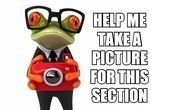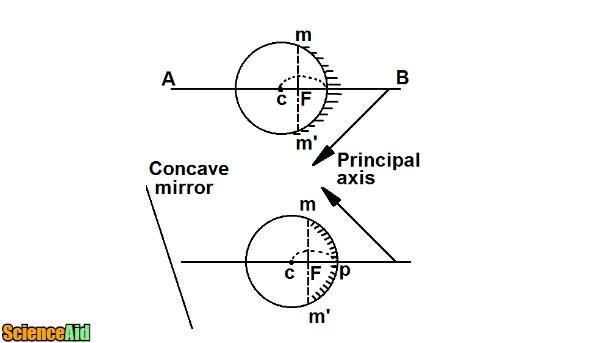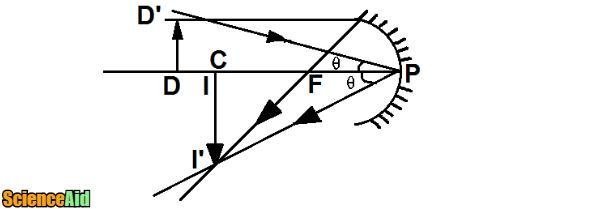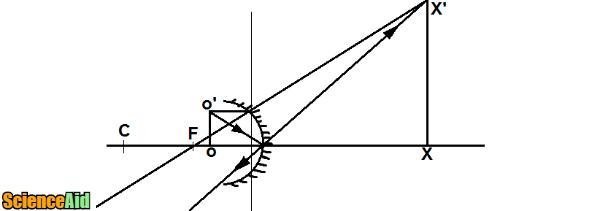Concave Mirrors
Edited by Sim, Jen Moreau
Concave Mirror
Definitions of Special terms
- 1
- 2The geometric center of a spherical mirror is called pole or vertex. It is denoted by 'P'.Pole:
- 3is the distance between the extreme points (MM') of the mirror OR The diameter of the mirror.Aperture:
- 4The straight line passing through the pole 'P' and the center of curvature 'C' is called the principal axis. AB is the principal axis in the fig.Principal Axis:
- 5converge to a point, called the principal focus, that is denoted by 'F'.Concave mirrors:
- 6The distance between pole 'P' and the principal focus 'F' is called focal length. It is denoted by 'f'. It is equal to half the radius of curvature. f = r/2 The focal length of a concave mirror is considered as positive.Focal Length:
Rules for Obtaining Images Formed by a Concave Mirror
When an object is placed in front of a concave mirror, an image is formed. The point of intersection of any of the two rays shows the image point "I" of object "O". The rays which are reflected from a concave mirror follow certain rules as under.
- 1A ray coming parallel to the principal axis is reflected through the principal focus of the concave mirror.
- 2
- 3
- 4
IMAGE FORMATION BY CONCAVE MIRROR
The type of images formed by a concave mirror depends on the position of the object to the mirror. If the distance of an object say OO' from a concave mirror is changed, then the nature, size, and location of the image are also changed.
Formation of different images depending on the position of the object are shown below:.
- 1
- 2
- 3
- 4
- 5(between 'F' and 'P'). When the object is placed between the pole and principal focus, then virtual, erect and larger image will be formed.Fifth Position:
Referencing this Article
If you need to reference this article in your work, you can copy-paste the following depending on your required format:
APA (American Psychological Association)
Concave Mirrors. (2017). In ScienceAid. Retrieved Apr 25, 2024, from https://scienceaid.net/Concave_Mirrors
MLA (Modern Language Association) "Concave Mirrors." ScienceAid, scienceaid.net/Concave_Mirrors Accessed 25 Apr 2024.
Chicago / Turabian ScienceAid.net. "Concave Mirrors." Accessed Apr 25, 2024. https://scienceaid.net/Concave_Mirrors.
If you have problems with any of the steps in this article, please ask a question for more help, or post in the comments section below.
Comments
Article Info
Categories : Physics
Recent edits by: Sim


















